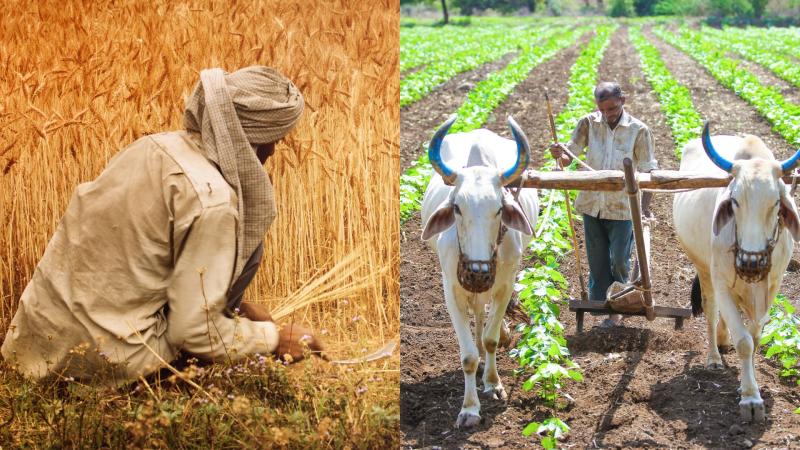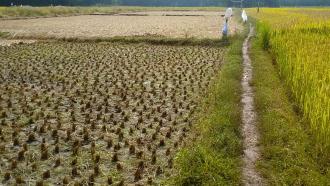
A new study from arid Bikaner in Rajasthan has demonstrated a novel, farm-level strategy to tackle the interconnected crises of water scarcity, energy demand, and climate change. It demonstrates that simple changes to crop choice and soil management can dramatically improve the sustainability of farming systems.
Researchers from the ICAR-Central Arid Zone Research Institute, ICAR-Indian Institute of Pulses Research, and ICAR–National Research Centre on Camel have found that replacing the traditional, water-guzzling cluster bean-wheat rotation with diversified, low-input systems like cluster bean-Indian mustard (CB-IM) and cluster bean-isabgol (CB-IG), and integrating practices like deep tillage (DT) and farmyard manure (FYM) application, dramatically improves resource efficiency and economic returns.
The research employed the Water-Energy-Food-Greenhouse Gas Nexus (WEFGN), a composite score that ranges from 0 to 1. A score closer to 1 indicates a more sustainable farming system, balancing high yield and profit with low water, energy, and greenhouse gas use. The team used this framework to evaluate three cluster bean-based cropping systems under different field management practices in the hot, arid Bikaner region of northwestern India over three years, from June 2015 to May 2018. This region is a major crop-producing area, but it faces acute water scarcity, with groundwater overexploited and water tables declining by more than 0.40 metres annually. The traditional cluster bean-wheat (CB-W) system, which requires substantial irrigation for winter wheat, was found to be the least sustainable option, requiring 1.26 to 1.38 times more water than the alternative systems.
The study showed that diversified systems (CB-IM and CB-IG) reduced groundwater irrigation by 27.9–37.2%, energy use by 22.9–37.4%, and greenhouse gas (GHG) emissions by 20.0–46.0% compared to the conventional CB-W system. Beyond crop choice, the research confirmed the critical role of field management practices. Deep tillage (DT), which involves ploughing the soil deeper than 25 cm, and the application of farmyard manure (FYM), which is manure produced from the farm's natural materials, were shown to significantly improve both water and energy productivity. Deep tillage enhances root growth, water infiltration, and plant-available water, while FYM improves soil structure, microbial activity, and nutrient availability.
The integration of DT and FYM practices with the diversified cropping systems boosted the overall WEFGN index by 16% for deep tillage and up to 36% for FYM application, demonstrating that a holistic approach is key to sustainable intensification. Furthermore, the alternative systems were found to be more economically productive. The most sustainable option, the cluster bean-isabgol (CB-IG) system under deep tillage with a high rate of farmyard manure application (10 Mg ha), achieved the highest WEFGN index score, indicating a sustainability level 2.8 to 4.2 times greater than the traditional cluster bean-wheat system. It also achieved the highest net profit and benefit-cost ratio, suggesting that replacing high-input wheat with lower-input, high-value crops, like isabgol and Indian mustard, enhances economic returns per unit of resource used. This shows that environmental protection and economic viability are not trade-offs but can be achieved simultaneously through smart diversification.
The study also highlights that the high environmental impact of conventional farming is intrinsically linked to its energy consumption. Non-renewable energy sources, such as electricity for irrigation, chemical fertilisers, and diesel, account for over 80% of the total energy used in these cropping systems. In fact, the researchers found a strong positive correlation between energy use and carbon dioxide equivalent emissions. This means that nearly all the GHG emissions are directly tied to the energy needed to power irrigation pumps and produce chemical inputs. Wheat, in particular, was identified as a high GHG-emitting crop because its cultivation requires 28–37% more nitrogen fertiliser and 40–196% more irrigation than Indian mustard or isabgol, driving up both energy use and emissions.
However, GHG emissions were estimated using standard emission factors, which, while practical, lack site-specific accuracy and do not capture short-term fluctuations in emissions driven by soil properties or climatic conditions. The authors recommend that future research should incorporate direct gas flux measurements to improve the accuracy of GHG emissions assessments.
Most existing research has focused on broad-scale assessments, often overlooking important farm-level heterogeneity such as soil type, climate, and specific field management practices. By evaluating the impacts of specific tillage types and organic manure application rates at the farm scale, this study provides context-specific, quantifiable data directly relevant to local decision-making and policy. It offers a crucial, integrated framework to capture the key trade-offs and synergies among productivity, resource use, and emissions that are often missed in conventional, isolated analyses. Moreover, this research provides an actionable roadmap for advancing sustainable agriculture in arid and semi-arid regions globally. The integrated approach outlined in the study is essential for securing food production and environmental sustainability for society today and in the future.
This article was written with the help of generative AI and edited by an editor at Research Matters.






